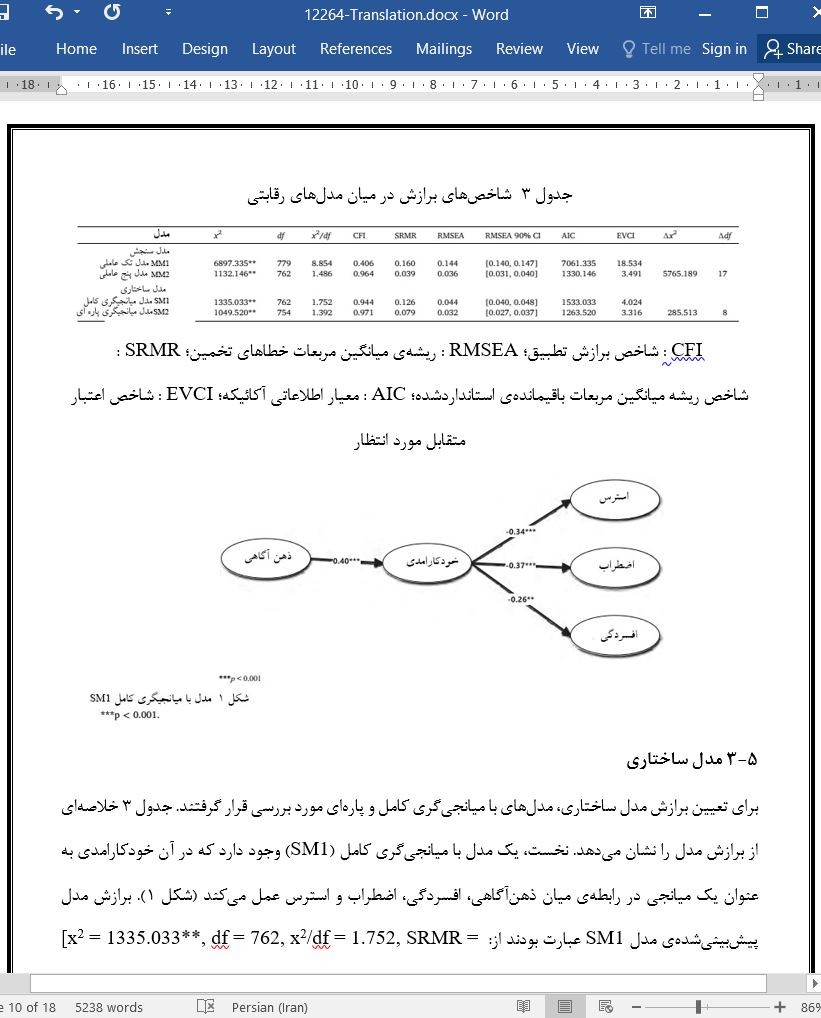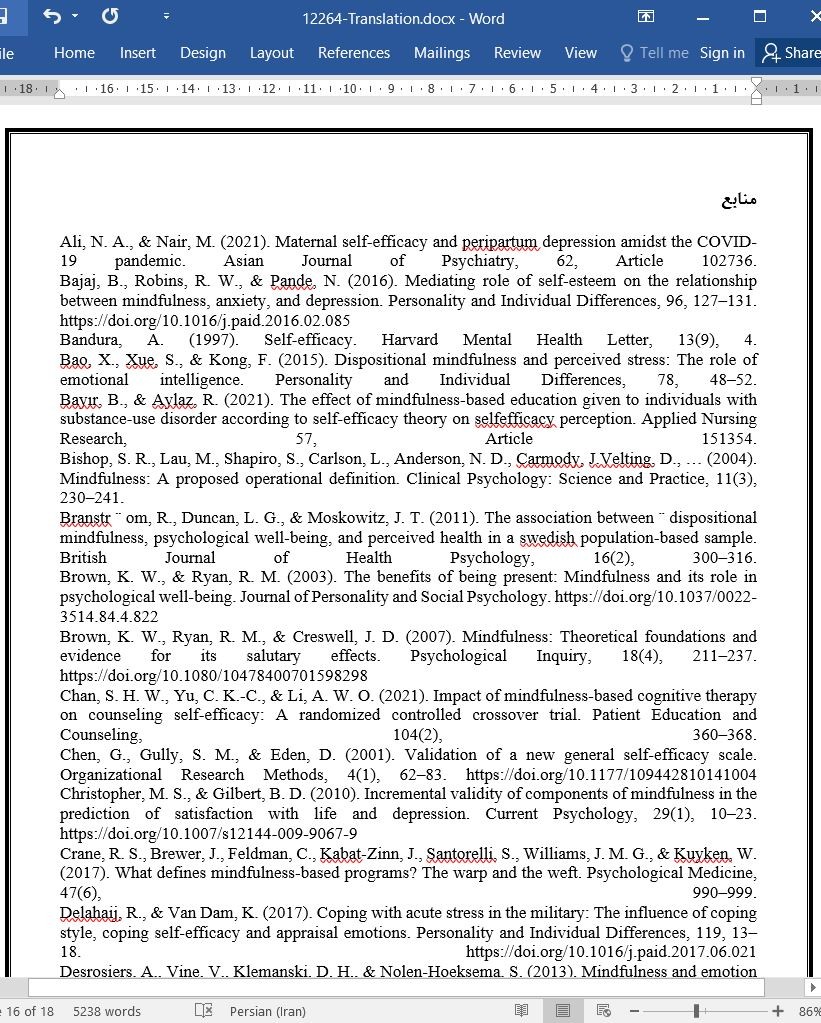
رابطه میان ذهن آگاهی، افسردگی، اضطراب و استرس
چکیده
این مطالعه با استفاده از مقیاس های خودگزارشی به بررسی رابطه ی میان ذهن آگاهی، خوکارامدی، اضطراب، افسردگی و استرس پرداخت. ما مقیاس بازنگری شده ی ذهن آگاهی شناختی و عاطفی (CAMS-R)، مقیاس خودکارامدی عمومی جدید (NGSE)، و مقیاس های افسردگی اضطراب استرس (DASS21) را برای یک نمونه ی غیربالینی از کارشناسان فن آوری اطلاعات (n=382) اجرا کردیم. یافته ها آشکار کردند که ذهن آگاهی به شکل مثبتی با خودکارامدی مرتبط است، در حالی که به شکل منفی ای با اضطراب، استرس و افسردگی مرتبط است. افزون بر این، خوکارامدی به شکلی منفی با اضطراب، استرس و افسردگی مرتبط بود. به واقع، بر پایه ی نتایج تحلیل میانجی گری، خودکارامدی به عنوان یک میانجی پاره ای در رابطه ی میان ذهن آگاهی، استرس و اضطراب عمل کرد.
1- مقدمه
در سال های اخیر شاهد موجی از پژوهش ها درباره ی ذهن آگاهی در رشته های روان شناسی، روانپزشکی، و رشته های مرتبط بوده ایم. ذهن آگاهی به خصوصیات، رویه ها و فرایندهای گوناگونی اشاره دارد که به یک حالت ذهنی مثبت توأم با آگاهی و نیز توجه غیربسطی و غیرقضاوتی منجر می شوند (بیشاپ و همکاران، 2004؛ براون و رایان، 2003؛ براون، رایان و کرسوِل، 2007؛ کابات-زین و هان، 1990). افزون بر این، ذهن آگاهی به شکل مثبتی با توانایی توجه کردن به هر دو محرّک درونی (مانند عواطف، شناخت ها، و پیامدهای رفتاری و تنی) و بیرونی (مانند تعامل اجتماعی، و محیط های پیرامونی) اما به شکلی بی غرضانه تر و با احساسات کم تر نسبت به گذشته مرتبط است (گلومب، دافی، بونو و یانگ، 2011). برخی از تعاریف رایج ذهن آگاهی عبارتند از: «توجه کردن به شکلی خاص: با قصد و غرض، در زمان کنونی، و بدون قضاوت» (کابات-زین، 1994).
4-1 محدودیت ها و مسیرهایی برای پژوهش های بیش تر
یافته های ما دارای محدودیت های خاص خودشان هستند. نخست، پاسخ دهندگان در مطالعه ی ما تحصیل کرده بودند (مهندس)، و در نتیجه کارمندان 'یقیه سفید' (شرکت فن آوری اطلاعات بخش خصوصی) بودند. بر پایه ی همین موضوع، آنان ممکن است در مقایسه با کارمندان با 'تحصیلات پایین تر' یا 'یقه آبی'، به لحاظ ایجاد دیدگاه خود آزادتر و فکرشان بازتر باشد. از همین رو، آنان نسبت به محیط سازمانی هوشیارتر و حساس تر بودند. مطالعات آینده ممکن است این پژوهش را تحت محیط های متنوع تری گسترش ببخشند، امری که شاید تعمیم-پذیری یافته های ما را بهبود ببخشد.
Abstract
This study used self-report measures to examine the connection between mindfulness, self-efficacy, anxiety, depression, and stress. We administered the Cognitive and Affective Mindfulness Scale-Revised (CAMS-R), New General Self-Efficacy Scale (NGSE), and Depression Anxiety Stress Scales (DASS21) to a non-clinical sample of Indian IT professionals (n = 382). The findings revealed that mindfulness was positively linked to self-efficacy, while it was negatively related to anxiety, stress, and depression. Furthermore, self-efficacy was negatively linked to anxiety, stress, and depression. In fact, according to the results of the mediation analysis, the role of self-efficacy worked as a partial mediator in the association between mindfulness, stress, depression and anxiety.
1. Introduction
Recent years have witnessed a surge in research on mindfulness across Psychology, Psychiatry and related disciplines. Mindfulness refers to various traits, practices, and processes that lead to a positive mental state characterized by awareness, along with non-elaborative and nonjudgmental attention (Bishop et al., 2004; Brown & Ryan, 2003; Brown, Ryan, & Creswell, 2007; Kabat-Zinn & Hanh, 1990). Further, mindfulness positively relates to the ability to pay attention to both internal (e.g., emotions, cognitions and their behavioral and somatic consequences) and external (e.g., social interaction, and environmental surroundings) stimuli, but more dispassionately than before (Glomb, Duffy, Bono, & Yang, 2011). Some of the common definitions of mindfulness include the following: “paying attention in a particular way: on purpose, in the present moment, and nonjudgmentally” (Kabat-Zinn, 1994).
4.1. Limitations and directions
for future research Our findings have their own limitations. To begin, the respondents in our study were educated (engineers), and thus were ‘white-collar’ (private sector IT company) employees. Based on the same, they may be more open to creating their own perspective than the ‘less-educated’ or the ‘blue-collar employees’. Resultantly, they were more alert and sensitive to the organizational environment
چکیده
1- مقدمه
1-1 ذهن آگاهی، اضطراب، استرس و افسردگی
1-2 خودکارامدی به عنوان میانجی
2- روش ها
2-1 شرکت کنندگان و رویه
2-2 مقیاس ها و سنجه ها
2-2-1 ذهن آگاهی
2-2-2 خودکارامدی
2-2-3 افسردگی اضطراب و استرس
3- نتایج
3-1 تحلیل داده ها
3-2 آمار توصیفی
3-3 روایی
3-4 مدل سنجش
3-5 مدل ساختاری
3-6 تحلیل میانجی گری
4- بحث
4-1 محدودیت ها و مسیرهایی برای پژوهش های بیش تر
منابع
Abstract
1. Introduction
1.1. Mindfulness, anxiety, stress and depression
1.2. Self-efficacy as mediator
2. Methods
2.1. Participants and procedure
2.2. Measures
2.2.1. Mindfulness
2.2.2. Self-efficacy
2.2.3. Depression anxiety and stress
3. Results
3.1. Data analysis
3.2. Descriptive statistics
3.3. Validity
3.4. Measurement model
3.5. Structural model
3.6. Mediation analysis
4. Discussion
4.1. Limitations and directions for future research
References
- اصل مقاله انگلیسی با فرمت ورد (word) با قابلیت ویرایش
- ترجمه فارسی مقاله با فرمت ورد (word) با قابلیت ویرایش، بدون آرم سایت ای ترجمه
- ترجمه فارسی مقاله با فرمت pdf، بدون آرم سایت ای ترجمه



